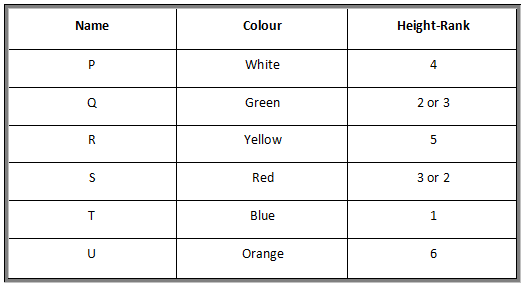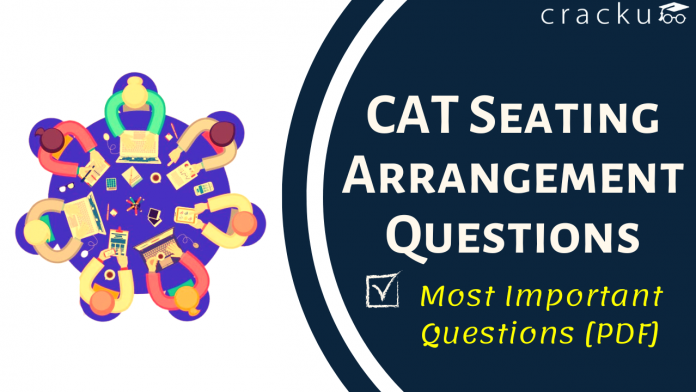Seating Arrangement Questions for CAT [Download PDF]
Arrangement is one of the most important topics in the CAT Quant Section. You can check out these Arrangement questions in the CAT Previous year’s papers. If you want to learn the basics, you can watch these videos on Arrangement. This article will look into some important Arrangement Questions for CAT. These are good sources for practice; If you want to practice these questions, you can download this CAT Arrangement Most Important Questions PDF below, which is completely Free.
Download Seating Arrangement Questions for CAT
Instructions
Directions for the following three questions: Answer the following questions based on the statements given below:
(i) There are three houses on each side of the road.
(ii) These six houses are labeled as P, Q, R, S, T and U.
(iii) The houses are of different colours, namely, Red, Blue, Green, Orange, Yellow and White.
(iv) The houses are of different heights.
(v) T, the tallest house, is exactly opposite to the Red coloured house.
(vi) The shortest house is exactly opposite to the Green coloured house.
(vii) U, the Orange coloured house, is located between P and S.
(viii) R, the Yellow coloured house, is exactly opposite to P.
(ix) Q, the Green coloured house, is exactly opposite to U.
(x) P, the White coloured house, is taller than R, but shorter than S and Q.
Question 1: What is the colour of the house diagonally opposite to the Yellow coloured house?
a) White
b) Blue
c) Green
d) Red
e) none of these
1) Answer (D)
Solution:
Before directly trying to answer the question, it is important to gather all the information given by the question.
There are three houses on each side of the road => Draw 6 lines, 3 in each row, to accommodate P, Q, R, S, T and U.
The houses are of different colours and different heights.
T is tallest and is opposite to red house => Let’s number T as 1.
Shortest house is opposite to green house.
U is orange and is between P and S => Two cases arise here. P-U-S is one possibility and the other possibility is S-U-P.

R is yellow and is opposite to P.
Q is green and is opposite to U. We know that green house is opposite to the shortest house. This implies that U is the shortest house => Number of U is 6.
P is white and is taller than R but shorter than S and Q => Apart from T, S and Q are also taller than P => S and Q can be 2 and 3 in any order => Number of P is 4 and number of R is 5.
We know that P is opposite to R and Q is opposite to U => S is opposite to T
It is given that T is opposite to red house => S is the red house and hence T is the blue house.
So, we know the colours of all houses and heights of P, R, T and U.
In this question, we are asked to find the house that is opposite to yellow house. R is the yellow house, P is opposite to R and S is on the other corner in P’s row. Hence S is the house that is diagonally opposite to yellow house and the colour of S is Red.

Question 2: Which is the second tallest house?
a) P
b) S
c) Q
d) R
e) cannot be determined
2) Answer (E)
Solution:
Before directly trying to answer the question, it is important to gather all the information given by the question.
There are three houses on each side of the road => Draw 6 lines, 3 in each row, to accommodate P, Q, R, S, T and U.
The houses are of different colours and different heights.
T is tallest and is opposite to red house => Let’s number T as 1.
Shortest house is opposite to green house.
U is orange and is between P and S => Two cases arise here. P-U-S is one possibility and the other possibility is S-U-P.

R is yellow and is opposite to P.
Q is green and is opposite to U. We know that green house is opposite to the shortest house. This implies that U is the shortest house => Number of U is 6.
P is white and is taller than R but shorter than S and Q => Apart from T, S and Q are also taller than P => S and Q can be 2 and 3 in any order => Number of P is 4 and number of R is 5.
We only know that the second tallest house is either Q or S. Hence the answer is cannot be determined.

Question 3: What is the colour of the tallest house?
a) Red
b) Blue
c) Green
d) Yellow
e) none of these
3) Answer (B)
Solution:
Before directly trying to answer the question, it is important to gather all the information given by the question.
There are three houses on each side of the road => Draw 6 lines, 3 in each row, to accommodate P, Q, R, S, T and U.
The houses are of different colours and different heights.
T is tallest and is opposite to red house => Let’s number T as 1.
Shortest house is opposite to green house.
U is orange and is between P and S => Two cases arise here. P-U-S is one possibility and the other possibility is S-U-P.

R is yellow and is opposite to P.
Q is green and is opposite to U. We know that green house is opposite to the shortest house. This implies that U is the shortest house => Number of U is 6.
P is white and is taller than R but shorter than S and Q => Apart from T, S and Q are also taller than P => S and Q can be 2 and 3 in any order => Number of P is 4 and number of R is 5.
We know that P is opposite to R and Q is opposite to U => S is opposite to T
It is given that T is opposite to red house => S is the red house and hence T is the blue house.
T is the tallest house and hence the colour of the tallest house is blue.

Instructions
DIRECTIONS for the following three questions: Answer the questions on the basis of the information given below.
A, B, C, D, E, and F are a group of friends. There are two housewives, one professor, one engineer, one
accountant and one lawyer in the group. There are only two married couples in the group. The lawyer is
married to D, who is a housewife. No woman in the group is either an engineer or an accountant. C, the
accountant, is married to F, who is a professor. A is married to a housewife. E is not a housewife.
Question 4: Which of the following is one of the married couples?
a) A & B
b) B & E
c) D & E
d) A & D
4) Answer (D)
Solution:
According to given conditions, we are able to infer following relations
So A and D are married couple.
Question 5: What is E’s profession?
a) Engineer
b) Lawyer
c) Professor
d) Accountant
5) Answer (A)
Solution:
According to given conditions we are able to infer,
Hence E is an engineer.
Question 6: How many members of the group are males?
a) 2
b) 3
c) 4
d) Cannot be determined
6) Answer (B)
Solution:
According to given conditions we are able to infer,
Thus, there are 3 males.
Instructions
DIRECTIONS for the following two questions: Answer the questions on the basis of the information given below.
The Head of a newly formed government desires to appoint five of the six elected members A, B, C, D, E and F to portfolios of Home, Power, Defence, Telecom and Finance. F does not want any portfolio if D gets one of the five. C wants either Home or Finance or no portfolio. B says that if D gets either Power or Telecom then she must get the other one. E insists on a portfolio if A gets one.
Question 7: Which is a valid assignment?
a) A-Home, B-Power, C-Defence, D-Telecom, E-Finance.
b) C-Home, D-Power, A-Defence, B-Telecom, E-Finance.
c) A-Home, B-Power, E-Defence, D-Telecom, F-Finance.
d) B-Home, F-Power, E-Defence, C-Telecom, A-Finance.
7) Answer (B)
Solution:
Since C wants either home or finance or none so options A and D are eliminated.
Since F does not want any portfolio if D gets one, Option C is eliminated.
Question 8: If A gets Home and C gets Finance, then which is NOT a valid assignment of Defense and Telecom?
a) D-Defence, B-Telecom.
b) F-Defence, B-Telecom.
c) B-Defence, E-Telecom.
d) B-Defence, D-Telecom.
8) Answer (D)
Solution:
B says that if D gets power or telecom then he must get the other one.Option D clearly violates that.
Instructions
DIRECTIONS for the following three questions: Answer the questions on the basis of the information given below.
Seven varsity basketball players (A, B, C, D, E, F, and G) are to be honoured at a special luncheon. The players will be seated on the dais in a row. A and G have to leave the luncheon early and so must be seated at the extreme right. B will receive the most valuable player’s trophy and so must be in the centre to facilitate presentation. C and D are bitter rivals and therefore must be seated as far apart as possible.
Question 9: Which of the following cannot be seated at either end?
a) C
b) D
c) F
d) G
9) Answer (C)
Solution:
According to given conditions we can conclude ,
Hence , F cannot be seated at either end.
Question 10: Which of the following pairs cannot be seated together?
a) B & D
b) C & F
c) D & G
d) E & A
10) Answer (D)
Solution:
According to given conditions following arrangements are possible,
Hence E and A cannot be seated together.







![CAT Averages Questions PDF [Important Questions] CAT AVERAGES Questions PDF](https://cracku.in/blog/wp-content/uploads/2022/07/CAT-AVERAGES-Questions-PDF-218x150.png)
